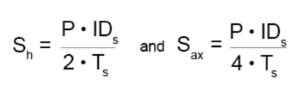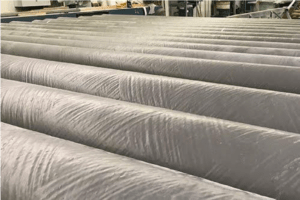Pressure Design of FRP Piping Components
HOME > Resources > Technical Center > Pressure Design of FRP Piping Components
Pressure Design of FRP Piping Components
In the previous article https://rps.charcoal.website/material-selection/, we discussed the importance of proper material selection including what issues need to be considered in making the best selection. In this article, we are going to take our first look at pressure design of FRP piping components. We are going to look in turn at the three types of piping components, i.e. pipe, fittings, and joints.
FRP piping components are manufactured with a corrosion barrier and a structural laminate. The corrosion barrier provides the chemical resistance needed to protect the structural laminate, and the structural laminate provides the structural integrity needed for the piping component to perform its intended function. Structural design of piping components starts with pressure design, i.e. determining the thickness of the component necessary to safely withstand the applied pressure. There are a number of different methods used to determine the required thickness of components, and we are going to consider the most commonly used methods as we begin our discussion on pressure design by first looking at pipe.
Straight lengths of pipe are by far the simplest component to design in any piping system. The geometry is easy to analyze (i.e. a cylinder) and samples are relatively easy to test. The stresses in a pipe when exposed to pressure are:

where:
Sh = Hoop stress
Sax = Axial stress
P = Pressure
IDs = Inside diameter of structural wall
Ts = Thickness of structural wall
The above equations can be rearranged to:

From these equations, it can be seen that the hoop stress due to pressure is approximately twice that of the axial stress. So it is generally sufficient to determine the wall thickness required by simply satisfying the hoop stress equation. This assumes that the axial tensile strength of the pipe is at least half that of the hoop tensile strength, which is true for most commercially available FRP pipe.
To determine the required structural wall thickness for a particular size of pipe, and for a particular magnitude of pressure, we need to know the value of the allowable hoop stress. The most common methods for determining allowable hoop stress for FRP pipe are:
- Long term pressure testing in accordance with ASTM D2992 to determine the long term hoop tensile strength, and application of a suitable Design Factor (not less than 2 for static test method). This testing requires about 1.5 years to complete, so it has generally only been used for commodity FRP piping or for standard products. For example, RPS HPPE P-150 pipe and A150 pipe have been tested using this test method.
- Short term pressure testing in accordance with ASTM D1599 to determine the short term hoop tensile strength, and application of a suitable Design Factor (typically in the range of 6 – 10). This testing can be completed in a relatively short period of time making it ideal for custom-designed pipe.
- Determination of the elastic properties of the pipe using either laminate analysis or testing, and then calculating the allowable stress from a pre-determined maximum allowable strain. Maximum allowable strains are typically in the range of 0.0010 – 0.0200 depending on the severity of the service.
To get a better idea for how each of these methods would be used, let’s look at an example of 12” diameter, 150 psi pipe using typical results from the three different methods:
In the long-term pressure test, a minimum of 18 pipe samples are tested at various pressure levels, and the time to failure is measured for each sample. The test method requires at least one sample to survive at least 10,000 hours (1.14 yrs). The failure pressures (stresses) and hours to failure for all samples are plotted on a Log-Log scale, and a best-fit curve is calculated for the data. The lower 95% prediction limit of the long-term pressure strength is then determined by extrapolating the data to the design life (ASME NM.2* requires a design life no less than 175,200 hours (20 yrs)). A typical value of long-term pressure strength for filament wound vinylester pipe would be 13,500 psi (93.1 MPa). Applying a Design Factor of 2 (minimum as required by ASME NM.2) results in an allowable hoop stress of 6750 psi (46.6 MPa). The required wall thickness would be (assuming a corrosion barrier thickness of 0.11”):

In the short-term pressure test, a minimum of 5 pipe samples are tested to failure in approximately 1 minute. The results are averaged, with a typical hoop tensile strength for filament wound vinylester pipe being 40,000 psi (276 MPa). Applying a Design Factor of 6 results in an allowable hoop stress of 6667 psi (46.0 MPa). Similar to above, the required wall thickness would be:

If we were to model a typical Filament Wound laminate using Laminate Theory, we would find that the hoop tensile modulus of the pipe would be approximately 2.3 x 106 psi (15,860 MPa). Multiplying the modulus by an allowable strain of 0.0020 would yield an allowable stress of 4600 psi (31.7 MPa). The required wall thickness would be:

As we can see from these values, the wall thicknesses based on test results are somewhat less than that based on laminate analysis. This is as it should be given that the test results are based on demonstrated properties.
It may appear that we have completed our design of the wall thickness for the 12” diameter 150 psi pipe, but we still need to consider the pipe’s ability to carry axial loads other than just pressure. Pipe, like all other piping components, will be exposed to axial loads such as bending between supports due to the weight of the pipe and its contents, bending due to constraint of thermal expansion, bending due to wind loads, etc. So the pipe must be capable of carrying axial loads other than just pressure. If the pipe is made by contact molding using layers of chopped strand mat and woven roving, the mechanical properties will be essentially the same in all directions. This type of composite is referred to as “quasi-isotropic”. Designing the wall thickness for hoop stress due to pressure will result in more than enough strength in the axial direction for the pressure stress, exactly double as a matter of fact. This provides significant additional capacity for those other axial loads.

However, FRP pipe is more commonly manufactured by filament winding with the fibers oriented at ± 55° to the pipe axis. This is the ideal winding angle for resisting pressure as it results in a hoop strength that is twice that of the axial strength, exactly matching the applied pressure stresses in a cylinder where the hoop stress is twice that of the axial stress. Such a laminate is referred to as “orthotropic”. While this type of construction is ideal for resisting pressure, if we only design for pressure, there will be no axial load-carrying capacity left over for the other axial loads. It is therefore necessary to provide additional axial load-carrying capacity so that the pipe will have an adequate design factor when all axial loads are considered. ASME NM.2 requires the wall thickness for this type of FRP pipe to be increased by a factor of 1.67. This additional wall thickness, while not required for pressure containment, will provide a significant additional axial load-carrying capacity for the non-pressure axial loads.
In our next article we will continue our look at pressure design of piping components by looking at the design of fittings and joints.
*ASME NM.2 – 2018 Glass-Fiber-Reinforced Thermosetting-Resin Piping Systems
Previous article in the series: Material Selection
Next in the series: Pressure Design of FRP Piping Components – Fittings and Joints



